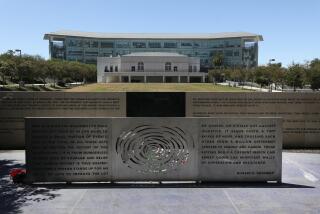An Ideal School System
At last Los Angeles schools have a blueprint for improvement. A committee of Los Angeles teachers and administrators started the process with a thorough look at what’s necessary to help children do better in class, at everything from ensuring that youngsters have breakfast to giving teachers more authority over curricula at individual schools. Now the Los Angeles Board of Education has approved that committee’s comprehensive and ambitious description of an ideal Los Angeles system. How much of that description and the plan for change that accompanies it will ever be put into effect depends on teamwork by the school district and state legislators. It also will take money.
The basic assumptions and strategies of the plan could well be followed beyond the borders of the Los Angeles district, in Orange County or other areas facing massive educational problems. The idea is that all students can learn and that every adult in every school should personally work toward helping every student, assumptions sometimes forgotten amid day-to-day pressures. The team that described the ideal said at the outset that black and Latino students in Los Angeles schools too often are placed in less rigorous academic programs than whites and are not expected to perform as well as they can. Calling these practices “institutional racism,” the committee said that low expectations were at least partly to blame for low test scores of black and Latino students.
To improve the opportunity for all students to do well in school, the panel called for a 10-year program that would cost $431 million.
There is much emphasis on helping very young students succeed early so they will be less likely to drop out of school later. For example, pre-school classes would be provided for all 4-year-olds. Fewer than half the district’s 413 elementary schools now have such programs. The district plan also aims at cutting class sizes from kindergarten through second grade from 30 children in many cases today to a maximum of 24 youngsters. It also calls for giving all elementary students the chance to attend summer school, starting next year.
Elementary school schedules would be revised so that teachers would have some time to plan for their classes. They don’t get paid for planning time now. The district also would set up teacher-training centers in schools now called “hard-to-staff” because students are from poor families and the schools are in tough neighborhoods.
Also important in an improved school system would be people or programs outside school that affect students such as counselors, school nurses and school cafeterias. The committee of teachers and administrators would improve nursing and counseling programs at elementary schools, for example, and guarantee each elementary school student a hot breakfast and lunch. Administrative aides would free teachers of much of the existing clerical work.
Finally, schools would be reorganized so that students from kindergarten through the fifth grade would attend school together, as would sixth- through eighth-graders and ninth- through 12th- graders. Big schools should be subdivided into “instructional units” of 500 students each to try to give students more individual attention. Most important, each school should have a decision-making team of parents, administrators, teachers and other employees who would run that school. Whether teachers should outnumber other members of that team is a volatile issue and remains subject to current union-district negotiations.
The plan, devised by teachers, administrators and the school board, offers a lofty vision of the future. But that, after all, is the responsibility of this generation to the next.
More to Read
Sign up for Essential California
The most important California stories and recommendations in your inbox every morning.
You may occasionally receive promotional content from the Los Angeles Times.










